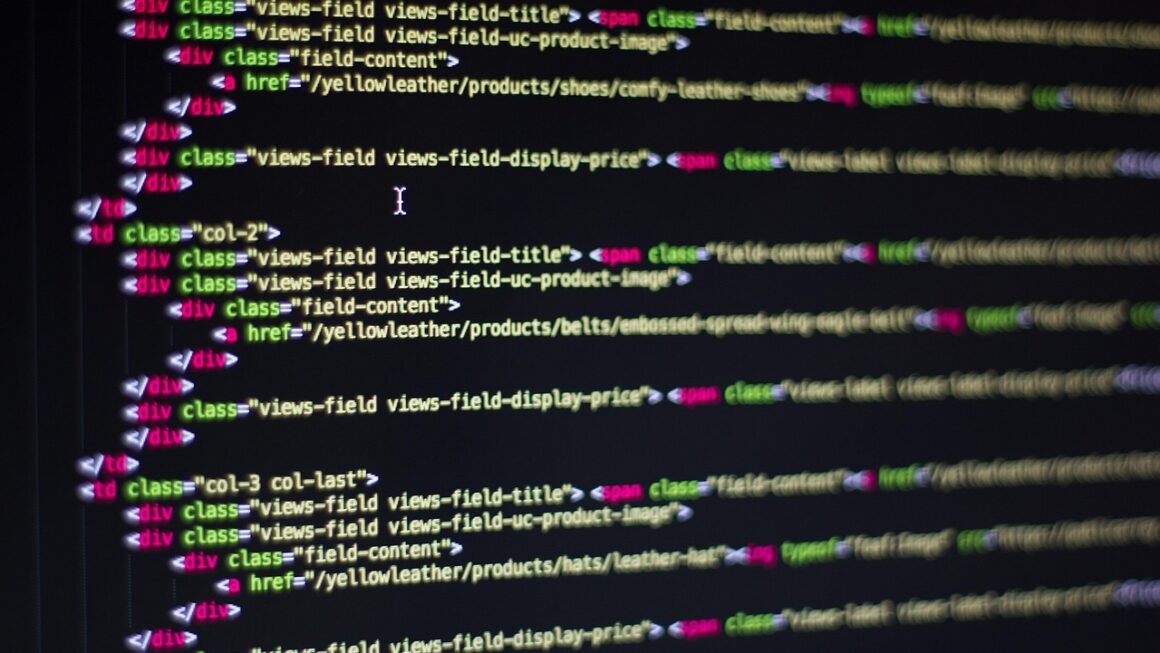The rapid evolution of artificial intelligence is transforming numerous fields, and software development is no exception. AI-generated code, once a futuristic concept, is now a tangible reality, offering developers powerful tools to accelerate their workflows, automate repetitive tasks, and even generate entire applications. This blog post delves into the world of AI-generated code, exploring its capabilities, benefits, challenges, and future potential.
Understanding AI-Generated Code
What is AI-Generated Code?
AI-generated code refers to code created by artificial intelligence algorithms, typically using machine learning models trained on vast datasets of existing code. These models learn patterns, syntax, and best practices from the training data and can then generate new code snippets, functions, or even complete applications based on user prompts or specifications.
- Generative AI: At its core, this technology leverages generative AI models that can produce new and original outputs, in this case, code.
- Machine Learning Foundation: Machine learning, specifically deep learning, forms the bedrock. Neural networks are trained on massive codebases to understand the nuances of different programming languages and paradigms.
- Prompt-Based Generation: Developers typically interact with AI code generators by providing prompts in natural language or through structured specifications. The AI then interprets the prompt and generates the corresponding code.
How Does it Work?
AI code generation relies on several key components:
- Training Data: The AI model is trained on a massive dataset of code, often including open-source projects, documentation, and code examples. This data helps the model learn the syntax, semantics, and common patterns of different programming languages.
- Natural Language Processing (NLP): NLP techniques are used to understand and interpret user prompts, allowing developers to interact with the AI in natural language.
- Code Synthesis: The core process of generating code from the user prompt, involving complex algorithms that translate the user’s intention into executable code.
- Code Verification and Testing: Some AI tools include built-in mechanisms for verifying and testing the generated code to ensure its correctness and functionality. This might involve static analysis or automated unit testing.
- Example: Imagine you need a Python function to calculate the factorial of a number. Instead of writing the code yourself, you could prompt an AI code generator with: “Write a Python function that calculates the factorial of a number.” The AI would then generate the code for you.
“`python
def factorial(n):
“””
Calculates the factorial of a non-negative integer.
“””
if n == 0:
return 1
else:
return n factorial(n-1)
“`
Benefits of Using AI-Generated Code
Increased Productivity and Efficiency
- Automation of Repetitive Tasks: AI excels at automating repetitive coding tasks, such as generating boilerplate code, writing unit tests, or converting code between languages. This frees up developers to focus on more complex and creative problem-solving.
- Faster Development Cycles: By automating code generation, AI can significantly reduce development time, allowing teams to deliver projects faster and more efficiently.
- Reduced Errors: AI can help reduce human errors in code, especially in tasks involving complex syntax or repetitive patterns.
Democratization of Software Development
- Lower Barrier to Entry: AI code generation tools can lower the barrier to entry for aspiring developers, allowing individuals with limited coding experience to create simple applications or prototypes.
- Empowering Non-Programmers: Even non-programmers can leverage AI to generate code for specific tasks, such as creating simple web pages or automating data analysis workflows.
- Improved Code Quality: AI models trained on best practices can generate code that adheres to coding standards and avoids common pitfalls, leading to improved code quality and maintainability.
Cost Savings
- Reduced Development Costs: By automating code generation and reducing development time, AI can significantly lower development costs for organizations.
- Improved Resource Allocation: With AI handling routine coding tasks, developers can focus on higher-value activities, leading to more efficient resource allocation.
- Faster Time to Market: Reducing development time translates to faster time to market for new products and services, providing a competitive advantage.
- Practical Example: A small startup might use AI to generate the initial codebase for a new mobile application, significantly reducing the time and cost required to get the project off the ground. This allows them to focus limited resources on core features and user experience.
Challenges and Limitations
Code Quality and Accuracy
- Potential for Errors: AI-generated code is not always perfect. It can sometimes contain errors, bugs, or inefficiencies, requiring careful review and testing by human developers.
- Lack of Contextual Understanding: AI may struggle with understanding the broader context of a project, leading to code that doesn’t integrate seamlessly with the existing codebase. It relies heavily on the clarity and completeness of the prompt.
- Bias in Training Data: If the training data contains biases, the AI may generate code that perpetuates these biases, leading to unfair or discriminatory outcomes.
Security Risks
- Vulnerabilities in Generated Code: AI-generated code may contain security vulnerabilities, such as SQL injection or cross-site scripting (XSS) vulnerabilities, which could be exploited by attackers.
- Reliance on External Dependencies: AI tools may rely on external libraries or dependencies that could introduce security risks if they are not properly maintained or audited.
- Prompt Injection: Malicious actors could craft prompts designed to trick the AI into generating malicious code.
Ethical Considerations
- Intellectual Property Rights: Questions arise about the ownership and copyright of AI-generated code, especially if it is based on existing code or algorithms.
- Job Displacement: The widespread adoption of AI-generated code could potentially lead to job displacement for some software developers, particularly those involved in routine or repetitive coding tasks.
- Responsibility for Code Errors: Determining responsibility for errors or vulnerabilities in AI-generated code can be challenging, raising legal and ethical concerns.
- Example: Imagine an AI generates code for a financial trading algorithm that leads to significant financial losses due to a bug. Determining who is responsible – the AI developer, the user who used the AI, or the algorithm itself – is a complex ethical and legal question.
Best Practices for Using AI-Generated Code
Thorough Review and Testing
- Human Oversight is Crucial: Always have a human developer thoroughly review and test AI-generated code to ensure its correctness, functionality, and security.
- Automated Testing: Integrate automated testing into your development workflow to catch errors and vulnerabilities early on.
- Code Quality Tools: Use code quality tools, such as linters and static analyzers, to identify potential issues in the generated code.
Clear and Precise Prompts
- Be Specific: Provide clear and precise prompts to the AI, specifying the desired functionality, input parameters, and output format.
- Break Down Complex Tasks: Break down complex tasks into smaller, more manageable prompts to improve the accuracy and quality of the generated code.
- Provide Examples: Include examples of expected input and output to help the AI understand your requirements.
Responsible Use and Ethical Considerations
- Understand the Limitations: Be aware of the limitations of AI-generated code and don’t rely on it blindly.
- Address Ethical Concerns: Consider the ethical implications of using AI-generated code, such as potential bias, job displacement, and intellectual property rights.
- Stay Informed: Keep up-to-date with the latest developments in AI code generation and its impact on the software development industry.
- Practical Tip: When using AI code generators, start with small, well-defined tasks and gradually increase the complexity as you gain confidence in the AI’s capabilities. Always validate the output carefully.
The Future of AI in Software Development
Enhanced AI Capabilities
- More Sophisticated Models: AI models will become more sophisticated and capable of generating more complex and nuanced code.
- Improved Contextual Understanding: AI will be better at understanding the context of a project, leading to code that integrates more seamlessly with existing systems.
- Automated Debugging and Refactoring: AI will be able to automatically debug and refactor code, further improving its quality and maintainability.
Integration with Development Tools
- Seamless Integration: AI code generation tools will be seamlessly integrated into existing IDEs and development workflows.
- AI-Powered Code Completion: AI will provide more intelligent code completion suggestions, helping developers write code faster and more efficiently.
- Automated Code Review: AI will automate code review processes, identifying potential issues and suggesting improvements.
New Roles for Developers
- AI-Assisted Development: Developers will work alongside AI, leveraging its capabilities to augment their skills and improve their productivity.
- Prompt Engineering: A new role of “prompt engineer” will emerge, focusing on crafting effective prompts to guide AI code generation.
- Focus on Higher-Level Tasks: Developers will focus on higher-level tasks, such as system design, architecture, and user experience, while AI handles more routine coding tasks.
- Prediction: In the future, software development will be a collaborative effort between humans and AI, with AI handling the grunt work and developers focusing on the creative and strategic aspects of building software. The role of the developer will evolve to be more of an architect and conductor, guiding the AI and ensuring the overall quality and functionality of the final product.
Conclusion
AI-generated code is a transformative technology with the potential to revolutionize software development. While it presents challenges and limitations, its benefits in terms of increased productivity, democratization of development, and cost savings are undeniable. By understanding its capabilities and limitations, adopting best practices, and embracing ethical considerations, developers can harness the power of AI to build better software, faster, and more efficiently. The future of software development lies in the collaboration between humans and AI, where AI augments human skills and allows developers to focus on the creative and strategic aspects of building innovative solutions.




